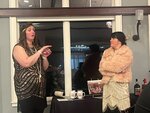The Hastings Golf Club and Events Center was transformed into a prohibition speak easy for the Dakota County Historical Society’s Holiday Soiree event held on Thursday, Dec. 28. The event …
This item is available in full to subscribers.
To continue reading, you will need to either log in, using the login form, below, or purchase a new subscription.
If you are a current print subscriber, you can set up a free website account and connect your subscription to it by clicking here.
Otherwise, click here to view your options for subscribing.
Please log in to continue |




The Hastings Golf Club and Events Center was transformed into a prohibition speak easy for the Dakota County Historical Society’s Holiday Soiree event held on Thursday, Dec. 28. The event benefits the LeDuc Historic Estate in Hastings.
Attendees were greeted with a “Complaint for Search Warrant Under State Law” for possession of forbidden spirits, dated 1921. They then were whispered a secret word that had to be repeated to gain entrance to the event where they could imbibe in a little “hooch” or “giggle water” as they may have said 100 years ago.
Attendees were invited to dress in prohibition-era attire and let me tell you some of those get-ups were the “bees’ knees,” if you will.
The cost of the ticket got you a selection of dinner of elected items that may have been served in the 1920s, done with that special Hastings Golf & Events touch, as well as a three-drink sampler while LeDuc Site Manager Mariah Ring and Nicole Sindelar of Hastings Golf & Events talked about the dinner and drink selections and about prohibition history, including a tale or two from the Hastings area. Sindelar is also a member of the Dakota County Historical Society Board of Trustees.
Board of Trustees President Steve Cook kicked off the event, noting it had doubled in attendance since last year’s event. He promised that someone was keeping an eye out for coppers.
“Know that we have taken the best precautions possible, but should we see an authority come here, you might want to decide to scramble. Hopefully, our little security system does work, and we’ll be keeping them out of here,” he joked.
Sindelar said that in researching the menu, it was hard to pinpoint the final entrée and sides.
“A lot of the stuff was not what I would call appetizing. Gelatin was a big thing. We actually joked about doing some kind of Jell-O, some kind of cocktail weenie gelatin mold,” she said.
They settled on starting with the Waldorf Salad made famous at the Waldorf Astoria Hotel. Biscuits were a dinner staple and went great with the family style feast of Chicken A La King with green beans and mashed potatoes, followed up with an authentic 1920s-era ice box cake.
In front of attendees were three cocktail samplers from the era, and Sindelar started off with describing the first of the drinks sampled throughout the dinner. The Bees Knees, a term that meant something was excellent was made with honey syrup, lemon juice and gin.
Later offerings were the Mary Pickford, made with rum, pineapple and grenadine and the classic bourbon Old Fashioned. Sindelar said drinks at the time were flavorful, perhaps because the food was a little more on the bland side.
Ring gave background on prohibition.
“You could actually legally drink alcohol during Prohibition. You just couldn’t technically manufacture it,” she said. “There were certain professions that could. For example, farmers were one of the people that got special permission to still make their own alcohol.”
“Prohibition didn’t stop the drinking of alcohol at all, which we know because we’re currently sitting in a speakeasy right?” she said to laughter from the crowd. “What it did was just drove the consumption of alcohol underground, but it also made it a lot more unsafe than it ever was before.”
She said new industries were invented to help people make their own alcohol. One company sold dehydrated grapes that would be put in a gallon of water.
“It was not recommended to store them in a cupboard or dark place for 17 days or it will turn into wine,” she said.
She said a separate act allowed people to consume wine in their own homes.
“Americans were allowed 200 gallons of wine a year to consume personally. Essentially, you were allowed to drink 2-1/2 bottles of wine a night in your house. There were some interesting loopholes there,” Ring shared.
She said that up to a quarter million illegal stills were removed from homes annually from 1920-25.
New friends – or partners in crime – were made at every table at the event, and people had personal stories to tell. In fact, legend in this reporter’s family is that his grandfather, who owned a saloon in Waseca, ran to Canada periodically with the county sheriff for whiskey.
Attendees were able to allude the lawman for a fun, successful night. Now, if I could only find that speakeasy again!